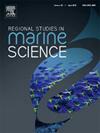印度西北大陆边缘上俯冲带近海范围的Re-Os同位素约束
IF 2.1
4区 环境科学与生态学
Q3 ECOLOGY
引用次数: 0
摘要
印度西北大陆边缘(NWCMI)与陆上超俯冲带(SSZ)型蛇绿岩杂岩(如穆斯林巴格和贝拉)并列,与印度板块和欧亚板块之间的长期辐合有关。先前的研究设想,这些南北向的SSZ复合体可能进一步向南延伸到阿拉伯海。然而,海上基底取样的缺乏阻碍了对这些主张的深入调查。鉴于最近在阿拉伯海北部Laxmi盆地(LB)的科学海洋钻探和取芯的发现,我们在这里评估陆上SSZ蛇绿岩复合体的海上延续。我们采用了新的地球化学特征,并首次报道了来自IODP 355考察U1457站点的LB基底的Re-Os同位素特征。LB火山岩地球化学特征显示出明显的SSZ地壳特征。这些特征包括低TiO2 (0.63-1 ppm)、低Zr (<50 ppm)、低Ti/V比率(10−20)和高场强元素逐渐耗尽的均匀模式(Nb和Zr的典型负异常),以及大离子亲石元素(K、Rb、Sr和Ba)的逐渐富集。利用鲁棒性分类图,将LB火山岩划分为弧前玄武岩(FAB)和硼岩质(B-FAB)。U1457站点的Re-Os同位素数据显示,Re浓度在1.37 ~ 1.97 (ppb)之间变化,Os浓度非常低(0.06 ~ 0.18 ppb)。超软质187Os/188Os比值(0.1683 ~ 0.2484)与俯冲衍生流体元素呈线性正相关,说明在俯冲起始过程中原始Os发生了变质。此外,通过比较NWCMI和Laxmi盆地的蛇绿岩,我们可以推断,陆上SSZ蛇绿岩带继续进入阿拉伯海,至少到LB。我们的新发现将对最终冈瓦纳散布的古板块重建具有重要意义。本文章由计算机程序翻译,如有差异,请以英文原文为准。
Re-Os isotope constraints on the offshore extent of supra subduction zone along the NW continental margin of India
The north-western continental margin of India (NWCMI) is juxtaposed with onshore supra-subduction zone (SSZ) type ophiolitic complexes (e.g. the Muslim Bagh and Bela) linked with protracted convergence between Indian and Eurasian plates. Prior studies envisaged that these N-S trending SSZ complexes, likely extend further south into the Arabian Sea. However, paucity of offshore basement sampling has impeded in-depth investigations into such propositions. In view of the recent findings from the scientific ocean drilling and coring in the Laxmi Basin (LB) of the northern Arabian Sea, here we assess offshore continuation of the onshore SSZ ophiolite complexes. We employ new geochemical and first report of Re-Os isotopic signatures of the LB basement from Site U1457 of the IODP Expedition 355. We report that the geochemical characteristics of the LB volcanics show unambiguous signatures of SSZ crust. These include low TiO2 (0.63–1 ppm), low Zr (<50 ppm), low Ti/V ratios (10−20) and uniform patterns of progressive depletion in high field strength elements, with typical negative anomalies of Nb and Zr, coupled with progressive enrichments in large ion lithophile elements (K, Rb, Sr and Ba). Using robust classification diagrams, the LB volcanics are categorised as forearc basalts (FAB) and boninitic FAB (B-FAB). The novel Re-Os isotope data from the Site U1457 show Re concentrations varying between 1.37 and 1.97 (ppb) and very low Os concentrations (0.06–0.18 ppb). The positive linear trend between suprachondritic 187Os/188Os ratios (0.1683–0.2484) with subduction derived fluid elements implies modification of original Os during subduction initiation process. Further, comparisons of ophiolites from NWCMI and Laxmi Basin allow us to infer that the onshore SSZ ophiolite belt continues into the Arabian Sea, at least till the LB. Our new findings would have significant implications towards paleo plate reconstructions of the final Gondwana dispersal.
求助全文
通过发布文献求助,成功后即可免费获取论文全文。
去求助
来源期刊

Regional Studies in Marine Science
Agricultural and Biological Sciences-Ecology, Evolution, Behavior and Systematics
CiteScore
3.90
自引率
4.80%
发文量
336
审稿时长
69 days
期刊介绍:
REGIONAL STUDIES IN MARINE SCIENCE will publish scientifically sound papers on regional aspects of maritime and marine resources in estuaries, coastal zones, continental shelf, the seas and oceans.
 求助内容:
求助内容: 应助结果提醒方式:
应助结果提醒方式:


